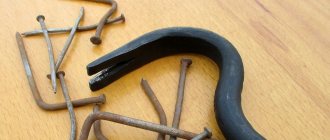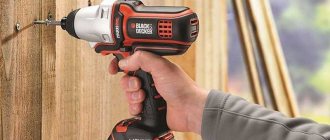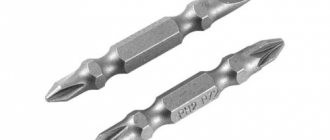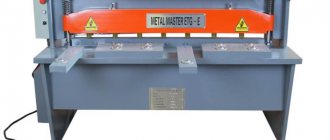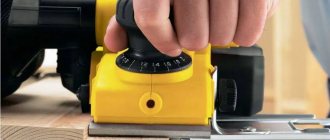To cut tiles, different tools are used - mechanical and electrical.
This is due both to different parameters of ceramics and to different amounts of work.
When laying tiles, there is almost always a need to adjust the tiles.
This procedure can only be performed with the help of a special tool, since this material is quite fragile, and its small thickness makes the operation even more difficult.
What is a glass cutter and what is it used for?
This type of tool, such as a glass cutter, is designed to reduce the size of flat glass, as well as adjust it to the appropriate dimensions.
The principle of operation of this device is that a scratch is applied to the surface of the glass, along the line of which a uniform fracture occurs. The tool has a simple design consisting of the following elements:
- The handle is the supporting part of the tool. Made from steel, wood or plastic
- The head is the working part, which looks like a hammer. The cutting element is attached to the head
- The cutting part or cutter is the base through which a furrow or groove is created
The cutting part is a carbide material that is coated with diamond or is a diamond crystal. There are two types of tool heads - movable and fixed. The movable head allows you to cut curved lines according to the template. The cutting element is attached to the head using silver solder. The cutter can be of three types:
- In the form of a four-sided regular pyramid - the angle of the cutting edge in relation to the holder should not be more than 30 degrees
- Curved design - straight edge projection has a tolerance of 0.015 mm
- The roller is the most popular type of cutting element, which is popular in the household.
Glass cutters are divided into types based on their operating principle. The simplest and cheapest are roller type tools. The most expensive are diamond models, on which a diamond cutter is installed. We will find out more about what types of glass cutters there are below.
Diamond blade
This method cannot be called safe. Processing sheets using a diamond disc requires special care and compliance with safety measures. But processing glass with a wheel allows you to quickly and efficiently cut a glass sheet. To work, you will need a grinder, a saw blade, diamond-coated with a thickness of 0.1 mm.
The cutting process is as follows.
The sheet must be laid on a flat surface. Then on the surface you need to run a machine, or rather a rotating disk, over the surface of the sheet. The touch must be careful. After this, a small groove should form, which in appearance resembles a wide line from a glass cutter. The glass can then be broken off at the designated location.
To reduce the risk of cracks and chips, it is advisable to water the cut area; by the way, the water will also bind the resulting glass dust.
Types of glass cutters and features of their use
Tools for cutting glass differ in such characteristic features as ease of work, as well as the quality of their performance. Professionals use more expensive and high-quality models, but for beginners, ordinary household glass cutters are suitable. Circular glass cutters are used to cut round glass products.
- Roller - from the name it is clear that the cutting element is presented in the form of a roller made of carbide materials. Often, tungsten carbide or high-speed steel are used as such. The handle is made of wood or plastic, and can be straight or curved. The shape of the handle affects the amount of force that can be applied to the fingers (when using a straight tool) and the elbow joint (when using a curved handle). The head is equipped with several rollers, which cannot be sharpened when dull. After the rollers wear out, it is easier to purchase a new tool, the cost of which starts from 100 rubles
- Diamond - unlike a roller, this type of glass cutter is a professional one. This means that the device can cut glass of any thickness. The cutting element is made of diamond chips, so it does not require the use of lubricants when cutting. The diamond glass cutter provides high-precision cutting of glass. The tip is attached to the head using silver solder, which can begin to crack if overloaded. The presence of a special screw on the handle allows you to replace or rearrange the tip, changing the edges. The cutting accuracy depends on the shape of the cutter, which can have a pyramidal or conical design. More precise cutting is achieved through the use of a pyramidal cutter. When the cutting edge wears, it is necessary to turn the cutter 90 degrees. It is necessary to choose a tool depending on the thickness of the glass being cut - up to 5 mm and over 10 mm. The most inexpensive glass cutter with a cutter made from diamond chips will cost from 250-300 rubles
- Oil - tools through which oil is supplied to the cutting area. The cutting element is made of high-speed steel, and the supplied lubricant is designed to produce a smooth cut. Oil allows you to increase the life of the cutter due to reduced friction during cutting. The oil container is located in the handle and is supplied to the cutter using a uniform or capillary method, depending on the design features. Uniform supply of lubricant is ensured through the use of a ball, which at the same time also serves as the final separation of the glass on the opposite side. When the oil is used up, it is replenished using a regular syringe. For lubrication, I-20A oil is used mainly, the main advantage of which is considered to be the absence of the effect of oxidation of the cutting element. Oil glass cutters cost from 200 rubles
- Circular - used to cut glass circles of different sizes. As a supporting device, the compass tool is equipped with a suction cup. The diameter of the cut glass circle is adjusted using a graduated scale on which the cutting element with a handle is attached. The cutting element has the ability to move along the scale
- Circular - if you need to cut an oval circle or ellipse. The design of the tool contains two fastening elements, which allows the cutting element to move along a complex trajectory. This tool is the most expensive, as it allows you to cut out the most complex shapes from glass. If you need to cut a circle or ellipse from glass, then it is not necessary to use a circular or circular glass cutter. A regular tool is suitable; a round or oval line is applied using a pre-prepared template.
If there is a need to use a tool for cutting glass, then it is not at all necessary to choose the most expensive models. For such cases, the cheapest roller glass cutter is suitable.
Tool selection
Before considering the question of how to cut correctly with a glass cutter, the debutant master needs to “arm himself”, which means he will have to choose and buy a tool in the event that it is not available on the farm. There are three types of mechanical devices. Therefore, you first need to either choose one of them, or purchase them all at once, in order to get a good opportunity to practice.
Diamond glass cutter
This “precious” instrument is suitable for both experienced craftsmen and beginners, but the latter will require training. In this device, a diamond plays the role of a cutter, which is soldered into the metal head of the tool. Its handle, like that of its simple “colleagues,” is made of plastic or wood.
If previously only natural stones were used for hand tools, now they have been partially replaced by artificial diamonds. Budget models are equipped with minerals that have a curved cutting edge. Expensive glass cutters have different cutters: these are tetrahedral stones inclined 20° to the cutting axis. The latter differ in the quality and depth of the groove, but working with them requires skill.
The cost of diamond glass cutters depends on the type of stone. Tools with natural minerals are more expensive, but they are enough to cut 10-15 km of glass, and even centimeter-thick glass is forced to succumb to the devices. Glass cutters with artificial diamonds are much more “modest” than their “elite” colleagues. Their maximum “kilometer range” is limited to 5 km; they are able to cope with material whose maximum thickness is 5 mm.
Roller implement
This is the simplest tool that can be found in any store. The main advantage of a roller glass cutter is its inexpensive price. Its working element is a roller made of hard alloy. Materials - tungsten carbide, carborundum, other alloys that are harder than quartz will also win.
More often, these glass cutters have several replaceable rollers (3-6): when the first element becomes dull, it is replaced with another. To do this, loosen the screw and turn the circle on which the cutters are attached.
If we talk about the first acquaintance with such work, then the roller glass cutter is a favorite because of the ease of working with it. However, it requires more pressure.
Oil glass cutter
It differs little from the roller variety: the design of this tool is similar, and to facilitate the procedure, the working cutter is lubricated with special oil, for which a reservoir is provided in the tool. When the cutter rotates, the product wets it, reducing friction, ensuring the quality of the cut. When the tool is not in use, lubricant does not flow out.
The advantages of these models are better splitting along the cut line, longer service life due to minimal wear of the cutter. If we compare an oil glass cutter with a roller type, then the first tool has a service life of 15 times longer.
In addition to these models, there are special devices - circular glass cutters, which allow you to cut not only circles, but also ovals (ellipses). These instruments differ in design. They are very similar to compasses.
How to choose the right glass
Glassmakers advise when choosing glass to pay attention to the following points:
- One of the signs of high-quality glass is a blue or greenish tint to its ends.
- Scratched sheets should not be used.
- If all the rules are not followed during the process of rolling glass or cooling it, then such sheets may have defects in the form of stripes. These stripes will significantly distort the image, so it is better not to use such sheets to replace glass in a window.
- The thickness of the glass depends on the size of the frame into which it is inserted. If its width and height are less than 600 mm, then you can get by with glass 2–2.5 mm thick. And if one of these parameters exceeds 600 mm, then the thickness of the glass sheet increases to 3.5–4 mm.
- When doing glazing at home, you need to cut a piece of glass 3–5 mm smaller than the size of the frame, because the slightest distortion will not allow the glass to be inserted into the opening.
How to cut correctly with a glass cutter?
There are no small details in this work, so all stages require utmost attention.
Preparatory activities
In order for the cut to be of high quality, it is necessary to first prepare the material for work. If the glass is new, then just wipe it. Newspaper is best suited for these purposes; it mainly wipes the surface dry and also does not leave lint or stains behind.
If the glass has been used before, then before cutting the material with a glass cutter, you will need to spend a little more time preparing it. First of all, such a surface will need to be washed thoroughly using special glass cleaning products. A thorough degreasing process should then be carried out. Alternatively, you can use kerosene. To do this, use a rag soaked in kerosene to thoroughly wipe the glass and wait until it dries completely.
At the same time, the glass preparation stage also includes cutting it. There is no doubt that you will be able to achieve the final result without waste, especially if you need to cut a product of irregular geometric shape. But if you make the calculation as correctly as possible, you can reduce the amount of waste several times.
Also, make sure that the working surface is fairly flat and without slopes, but not too hard; it is advisable to make the working surface from plywood or fiberboard, and cover the top with oilcloth or soft cloth.
What will you need for the job?
Glass and glass cutter are not the only things you need to prepare. Therefore, it is better to “announce the entire list” first. It includes:
- desktop with a perfectly flat surface;
- ruler (straight edge), tape measure, square;
- sandpaper (file, stone);
- threads, fabric, solvent;
- rubber mallet.
A metal ruler is ideal. It is better to look for a fairly thick tool suitable for the stop of the glass cutter: its minimum thickness is 8 mm. Experts use rulers with suction cups. Since such a tool is usually not available on the farm, an alternative has long been invented. This is a metal ruler with a thin rubber strip glued on it.
You can’t do without a marker, and a pencil can serve as a stand needed for breaking a small glass sheet along the cut line.
Cutting glass
Any debut requires slowness, caution and accuracy. This is absolutely true for hazardous glass.
- First it is marked. To draw a line, use a long metal or wooden ruler, a tape measure, or a completely straight strip. The second tool you need is a glass marker (felt-tip pen), which leaves the thinnest possible line.
- Then small marks are made at both ends of the drawn line. Apply a ruler to the glass, take a glass cutter and draw a line, applying a little force. The pressure towards the edge of the glass should release slightly to prevent chipping of the material and damage to the instrument.
- The diamond glass cutter is held in the same way as a pencil or fountain pen, with a slight tilt. Roller and oil - perpendicular to the surface. In the first case, a barely noticeable mark should remain on the glass - a colorless thin line, in the second it should turn white, and the work should be accompanied by a characteristic crackling sound. The line is drawn only once. A second cut in the same place is prohibited.
- A flat strip or small block is placed under a piece of cut glass to break the material along the cut line. First, tap it with the handle of a glass cutter on the reverse side to slightly deepen the crack, thereby making the upcoming operation easier. The prepared glass is carefully broken. As a rule, this does not require excessive effort.
When it is necessary to break off a thin strip, either use pliers or a glass cutter, which has special grooves designed for this purpose.
Fracture methods
After a cut with deep cracks is made on the surface, you will need to divide the workpiece along this line. This operation is performed in four ways:
- manual bending;
- using matches or thin sticks;
- on the edge of the table;
- by tapping method.
Tapping method
The glass is placed on the edge of the table, extending the cutting line beyond its limits. Hold the part to be cut with one hand. Using the glass cutter head, precise blows are applied to the place where the middle cracks form. They gradually expand and deepen due to the loads created.
The peculiarity of the method is that the impact should not develop lateral cracks caused by deformation of the glass during cutting. They will create an uneven chip and ruin the workpiece.
During the application of blows, the expansion of the chip is visually observed.
Bend on the edge of the table
Glass with a scratch is placed on the edge of the working surface of the table with the cutting line facing up. Combine it with the edge of the stop.
With the palm of one hand they press the glass surface to the table, and with the other they grab the protruding edge and with a sharp downward movement separate the workpiece.
The method is well suited for beginners.
Manual bending of the workpiece
The glass is taken by the edges near the cutting line with your hands, squeezed tightly with your fingers and an opposite bending twisting force is created, directed outward from the groove made.
This is quite enough to accurately separate the workpiece from the main sheet. This method is used by most glaziers.
Bend on matches
Matches or thin, even wooden sticks are placed in one line on the table. The glass is placed on them with a cut line so that the scratch is located on top.
Place your palms evenly over the surface and break the glass with a sharp downward movement. The magnitude of the force is determined experimentally, starting with small values.
The fracture is smooth and of high quality.
If the break doesn't work out
We must be prepared for such a situation. It can occur due to lack of experience or technology violations.
The damaged part on the protruding side of the unbroken edge can be carefully removed using the slots on the side of the glass cutter or pliers. The edges will be sharp and jagged. They will have to be ground down with an emery stone.
The correct cut on glass is created through skills developed based on an understanding of the design features of glass and the technology of the glass cutter.
How to cut a circle from glass
In order to cut a circle out of glass, you can use several different methods, which may differ depending on the diameter of the future circle and, of course, the thickness of the glass.
The simplest and most common way to cut an even circle is to use a circular glass cutter. Usually, the presence of such a tool in the household is quite rare. But for these purposes you can use a regular tool.
How to correctly cut a circle from glass with a glass cutter video
First of all, you will need to mark the central part of the future product and attach a special suction cup to it. Then you need to tie a strong thread or fishing line to this suction cup with a length equal to the radius of the planned circle. The glass cutter itself must be tied to the end of this rope. Pull the rope as tight as possible and then draw a line with the tool in a circle around the suction cup. When the circle is drawn, it is very important to additionally make ray lines that will eliminate excess pieces of glass around the finished product.
Preparation of the workplace
Before cutting or cutting glass, you should prepare for the job. You must take care of the safety of the workplace, as well as the convenience and quality of glass cutting. To do this you need:
- Prepare a workplace that should take into account the specifics of cutting work. You will carry out all operations on a special table, which must have at least the same dimensions as the sheet. But it is better if it is 50-100 mm larger than the dimensions of the glass. The table must be positioned in such a way that there is a passage of at least 1 meter on each side. On one side, clear a space equal to the longest side of the table. You will need it for storing cut sheets, broken glass and leftover material. The table should have as smooth a surface as possible, so we recommend that in any case you put a thick sheet of chipboard 30 mm thick on it. In addition to this, it can be covered with a soft cloth. Be sure to clear all aisles of unnecessary items.
- For tools for cutting glass or cutting a mirror, you will need a glass cutter, a pattern and a measuring tool. Before work, make sure that the glass cutter is in good condition by drawing a line on a piece of glass.
- Plan for yourself the scope of upcoming work. To do this, you will need to measure the windows or other structures that you are going to glaze.
Features of working with non-standard glass
Tempered glass cannot be processed at home; when mechanical stress is applied to it, it crumbles or breaks into pieces. Corrugated - cut with a glass cutter in the same way as a regular one, but on the smooth side.
Acrylic glass is not actually glass. Thin material is cut using simple scissors or an ordinary knife. A thick sheet can be drawn along a ruler with a piece of a hacksaw blade, several times, and then bent and broken along the groove line.
Burning thread
This method is most often used for cutting bottles made of glass. This method can also be used for cutting sheet material. To complete the work you will need a piece of wool thread, fuel and a container for water.
The thread must be moistened in fuel and fixed to the glass along the cut line. Then the thread soaked in liquid fuel must be set on fire and after it is completely burned out, the glass must be dipped into cold water. Once the cut is made, a characteristic click will sound.
This method works on bottles. When using it, fire safety precautions must be observed.
Possible mistakes
Most often, inexperienced carvers make the following erroneous actions:
- When cutting corrugated glass, they do not use a roller tool, but a different model of glass cutter. In addition, frosted glass with patterns and grooves is not cut from the smooth side;
- The dimensions of the final workpieces are often not respected. Trimming should be done in such a way that the dimensions are a couple of millimeters smaller than the frame into which the glass is planned to be inserted;
- when working with a glass cutter, additional materials are ignored - patterns, which are special rulers;
- It is recommended to ensure that the glass cutter is suitable for use before each cut. To do this, its sharpness is checked - a piece of glass is cut off on already cut pieces. If during cutting you hear an unpleasant creak, the cutting edge needs to be sharpened.
The glass cutter must be checked before each cut.
Safety regulations
When starting the procedure for cutting glass, be sure to keep in mind that working with this material requires compliance with safety rules, which are not recommended to be neglected. When untreated, glass has sharp edges that can easily cut the skin and cause infection. To avoid cuts, protect your hands with gloves and wear clothes with sleeves. Since glass tends to crumble into small, sharp fragments, we strongly recommend cutting with glasses.
The glass cutting area must be level and stable. It is strictly not recommended to perform this operation on a knee, a rickety stool, or other questionable surfaces. Compliance with this rule will minimize the risk of glass falling onto the floor, and will also make the work more convenient and improve the quality of the cut.
If you have not previously had experience in handling glass, and do not yet know how to cut with a glass cutter, we do not recommend neglecting the above recommendations. Perhaps some experienced craftsmen can do this work with their eyes closed on their knees, but for beginners everything usually does not go so smoothly. Due to inexperience, you can make many mistakes: grab a sharp edge, drop the glass on your foot, or crush the cut site and get a piece of glass in your eye. If you are working with glass for the first time, and have not yet experienced this process, it is best to be fully prepared.
If you liked the article, please share it
Previously on the topic:
Share


